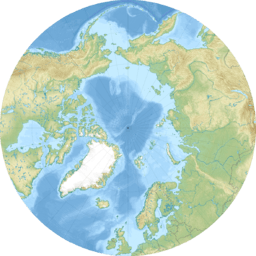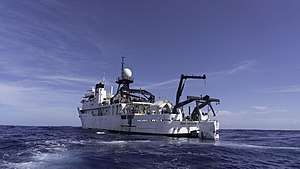Molloy Deep

The Molloy Deep (also known as the Molloy Hole) is a bathymetric feature in the Fram Strait, within the Greenland Sea[1] east of Greenland and about 160 km west of Svalbard. It is the location of the deepest point in the Arctic Ocean.[2][3][4][5][6][7][8]
The outer rim of the trench is at a depth of 2,700 m (8,900 ft) and contains about 600 km2 inside the rim, descending to approximately 5,550 m (18,210 ft) at its greatest depth. The basin floor measures about 220 km2, and is the deepest point in the Arctic Ocean.[9][10] The first and only person to have reached the bottom of the Molloy Deep is American explorer Victor Vescovo, as part of his Five Deeps Expedition.
Geology
The Molloy Deep is a roughly rectangular, seismically active,[11] extensional,[12] sea-floor basin, that lies between the northwestern tip of the Molloy Fracture Zone,[13] (a right-lateral,[14] strike-slip fault[15]), and the Spitsbergen Fracture Zone (also a right-lateral, strike-slip fault). These two fracture zones connect the Knipovich Ridge (the actively spreading northern segment of the Mid-Atlantic Ocean ridge system), with the Lena Trough, an actively spreading mid-ocean ridge region north of the Spitsbergen Fracture Zone. The Lena Trough joins the southwestern end of the Arctic Ocean's Gakkel Ridge[16] which is the slowest spreading mid-ocean ridge on Earth,[17][18] and which stretches across the entire Arctic Oceans’ Eurasian Basin.[19]
History

The Molloy Deep was discovered in September 1972 by the USNS Hayes (T-AGOR 16), the first of a new class of catamaran-hulled oceanographic research vessels. The Molloy Deep, Molloy Hole, Molloy Fracture Zone, and Molloy Ridge were named after Arthur E. Molloy, a U.S. Navy research scientist who worked in the North Atlantic, North Pacific and Arctic Oceans in the 1950s-1970s.[20]
Manned descent
The first, and so far only, person to reach the bottom of the Molloy Deep is Victor Vescovo on 24 August 2019.[8][21] The Five Deeps Expedition leader and chief submersible pilot, Vescovo, descended into the Malloy Deep in the Deep-Submergence Vehicle DSV Limiting Factor (a Triton 36000/2 model submersible) from the support ship, the Deep Submersible Support Vessel DSSV Pressure Drop.[22] The Five Deeps Expedition established the depth of the Molloy Deep as 5,550 m (18,210 ft) ±14 m (46 ft) by direct CTD pressure measurements.[23] This is shallower than previous estimations using earlier technology with less precise bathymetric methods.
References
- "Fram Strait Bathymetry". Alfred Wegener Institute for Polar- and Marine Research. Archived from the original on 14 May 2013. Retrieved 2 October 2012.
- IHO-IOC GEBCO Gazetteer of Undersea Feature Names (2018-06-25), available online at http://www.ngdc.noaa.gov/gazetteer/
- Thiede, Jörn; Pfirman, Stephanie; Schenke, Hans-Werner; Reil, Wolfgang (1990). "Bathymetry of Molloy Deep: Fram Strait between Svalbard and Greenland". Marine Geophysical Researches. Springer. 12 (3): 197–214. Bibcode:1990MarGR..12..197T. doi:10.1007/BF02266713.
- Klenke, Martin; Schenke, Hans Werner (2002-07-01). "A new bathymetric model for the central Fram Strait". Marine Geophysical Researches. 23: 367–378. Bibcode:2002MarGR..23..367K. doi:10.1023/A:1025764206736.
- Bourke, Robert; Tunnicliffe, Mark; Newton, John; Paquette, Robert; Manley, Tom (1987-06-30). "Eddy near the Molloy Deep revisited". Journal of Geophysical Research. 92: 6773–6776. doi:10.1029/JC092iC07p06773.
- Thiede, Jörn; Pfirman, Stephanie; Schenke, Hans Werner; Reil, Wolfgang (1990-08-01). "Bathymetry of Molloy Deep: Fram Strait between Svalbard and Greenland". Mar. geophys. Res. 12: 197–214. Bibcode:1990MarGR..12..197T. doi:10.1007/BF02266713.
- Freire, Francis; Gyllencreutz, Richard; Jafri, Rooh; Jakobsson, Martin (2014-03-31). "Acoustic evidence of a submarine slide in the deepest part of the Arctic, the Molloy Hole". Geo-Marine Letters. 34: 315–325. doi:10.1007/s00367-014-0371-5.
- "Five Deeps Expedition is complete after historic dive to the bottom of the Arctic Ocean" (PDF).
- Freire, F.; Gyllencrentz, R.; Jafri, R.U.; Jakobsson, M. (2014). "Acoustic evidence of a submarine slide in the deepest part of the Arctic, the Molloy Hole". Geo-Marine Letters. 34: 315–325. doi:10.1007/s00367-014-0371-5.
- Jakobsson; et al. "The International Bathymetric Chart of the Arctic Ocean (IBCAO) Version 3.0". Geophys Res Lett. 39: 1–6. doi:10.1029/2012GL.052219.
- Laderach, C., et al. (2011). Seismicity and active tectonic processes in the ultra-slow spreading Lena Trough, Arctic Ocean. Geophysical Journal International, v.184, pp. 1354–1370. doi.org/10.1111/j.1365-246X.2010.04926
- Baturin, D.G. (1990). "Structure and Geodynamics of the Molloy Transform Fracture Zones in the Mid-Ridge System of the Norway–Greenland Oceanic Basin". Okeanologiya. 30 (3): 436–443.
- JThiede, J.; et al. (1990). "Bathymetry of Molloy Deep: Fram Strait Between Svalbard and Greenland". Marine Geophysical Researches. 12: 197–214. Bibcode:1990MarGR..12..197T. doi:10.1007/bf02266713.
- Chamov, N. P.; Sokolov, S. Yu.; Kostyleva, V. V.; Efimov, V. N.; Peive, A. A.; Aleksandrova, G. N.; Bylinskaya, M. E.; Radionova, E. P.; Stupin, S. I. (2010). "Structure and composition of the sedimentary cover in the Knipovich Rift valley and Molloy Deep (Norwegian-Greenland basin)". Lithology and Mineral Resources. 45 (6): 532–554. doi:10.1134/S0024490210060039.
- Chamov, N. P.; Sokolov, S. Yu.; Kostyleva, V. V.; Efimov, V. N.; Peive, A. A.; Aleksandrova, G. N.; Bylinskaya, M. E.; Radionova, E. P.; Stupin, S. I. (2010). "Structure and composition of the sedimentary cover in the Knipovich Rift valley and Molloy Deep (Norwegian-Greenland basin)". Lithology and Mineral Resources. 45 (6): 532–554. doi:10.1134/S0024490210060039.
- https://www.thoughtco.com/fault-types-with-diagrams-3879102
- Cochran, J.R.; et al. (2003). "The Gakkel Ridge: Bathymetry, gravity anomalies, and crustal accretion at extremely slow spreading rates". Journal of Geophysical Research. 108 (B2): 2116. doi:10.1029/2002JB001830.
- Nikishin, A.M.; et al. (2018). "Eurasia Basin and Gakkel Ridge, Arctic Ocean: Crustal asymmetry, ultra-slow spreading and continental rifting revealed by new seismic data". Tectonophysics. 746: 64–82. doi:10.1016/j.tecto.2017.09.006.
- Gakkel Ridge
- Burton G. Hurdle (ed.), The Nordic Seas: Springer-Verlag, 1986; pp.227-28.
- Amos, Jonathan (2019-09-09). "US adventurer reaches deepest points in all oceans". Retrieved 2019-09-10.
- "Full Ocean Depth Submersible LIMITING FACTOR". fivedeeps.com. Retrieved 2019-10-10.
- Five Deeps Expedition (2019-09-09). "Five Deeps Expedition is complete after historic dive to the bottom of the Arctic Ocean" (PDF). Retrieved 2019-10-10.